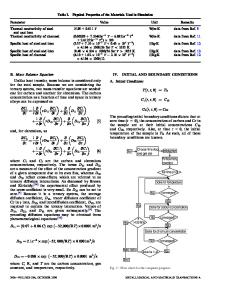Mathematical modeling of the argon-oxygen decarburization refining process of stainless steel: Part I. Mathematical mode
- PDF / 140,961 Bytes
- 9 Pages / 612 x 792 pts (letter) Page_size
- 63 Downloads / 434 Views
I. INTRODUCTION
THE keys for the refining of stainless steel are how to remove effectively the carbon in the steel and to raise the chromium recovery. In the various refining technologies of stainless steel, the argon-oxygen decarburization (AOD) process has a number of obvious advantages; thus, it has been applied extensively and developed rapidly throughout the world. At present, over 75 pct of the world’s stainless steel output is produced using the process. Simultaneously, many studies on mathematical modeling for the AOD refining of stainless steel have been carried out, and numerous models have been proposed and developed to attempt to accomplish optimization and computer control of the process.[1–11] Taking the AOD refining of low-carbon and high-chromium stainless steel as an example, Ray and Szekely[1] examined and analyzed the mathematical modeling of this process in the discussion of process optimization methods. Following this work, based on the mass and heat balances of the system and the film theory of diffusion, Asai and Szekely[2,3] proposed a mathematical model for the decarburization of stainless steel. The essential assumption was that the oxygen supplied to the metal is either used to participate selectively in decarburization and the oxidative reactions of Cr and Si, thus forming CO, Cr2O3, and SiO2, or it accumulates in the metal phase. The model did not allow for the formation of FeO explicitly; namely, it postulated that JI-HE WEI, Professor, is with the Department of Metallic Materials, Shanghai University, Shanghai, 200072, People’s Republic of China. DE-PING ZHU, formerly Graduate Student, Department of Metallic Materials, Shanghai University, is Engineer, Shanghai Wensi Sorftware Limited Company. Manuscript submitted January 9, 2001. METALLURGICAL AND MATERIALS TRANSACTIONS B
the oxygen transfer from the FeO part of the slag to the metal is quite rapid. Applying the model to the refining process in an oxygen-blown, electric furnace of 40-t capacity, the predictions and measurements showed quite good agreement. The first deficiency of this model is that the discrepancy of decarburization patterns at high and low carbon levels was not noted. Second, according to this model, the rate parameters used were the conductances determined by consider all the resistances of the system to transfer, i.e., mass transfer, chemical kinetics, mixing, etc. So, the values of these conductance parameters for different components in the bath must be different under different operating conditions. However, it was assumed that the values of these parameters for the overall transfer of C, O, Cr, and Si under different operating modes were equal and constant. These assumptions, combined with the assumption that all nonreacting oxygen is accumulated in the molten stainless steel, are in clear contradiction to known phenomena and likely to lead to errors in predicting the kinetics of the AOD processes. Fruehan[4] assumed that most of the oxygen blown is consumed in the oxidation of chromium in the tuyere zone, and
Data Loading...











